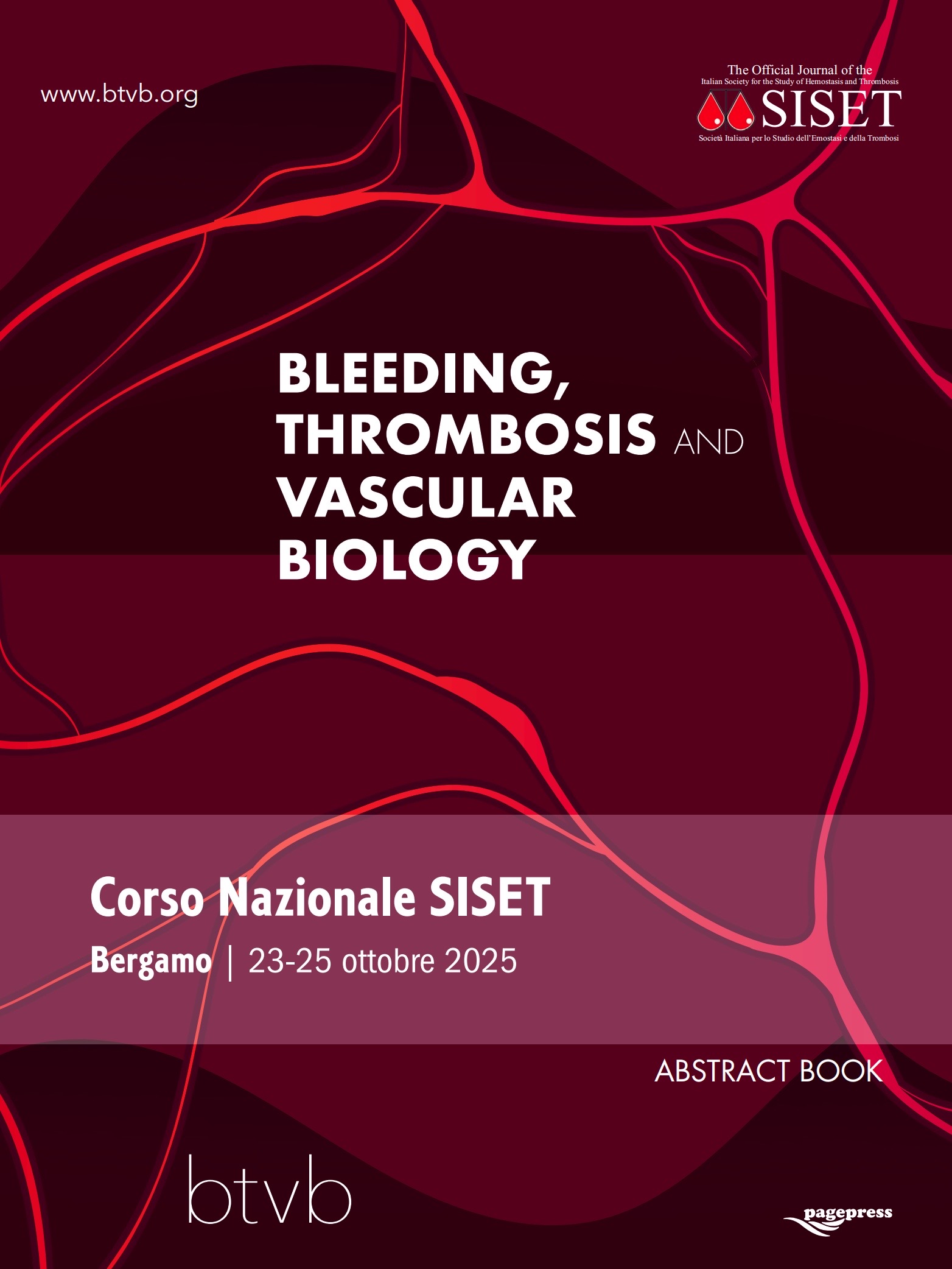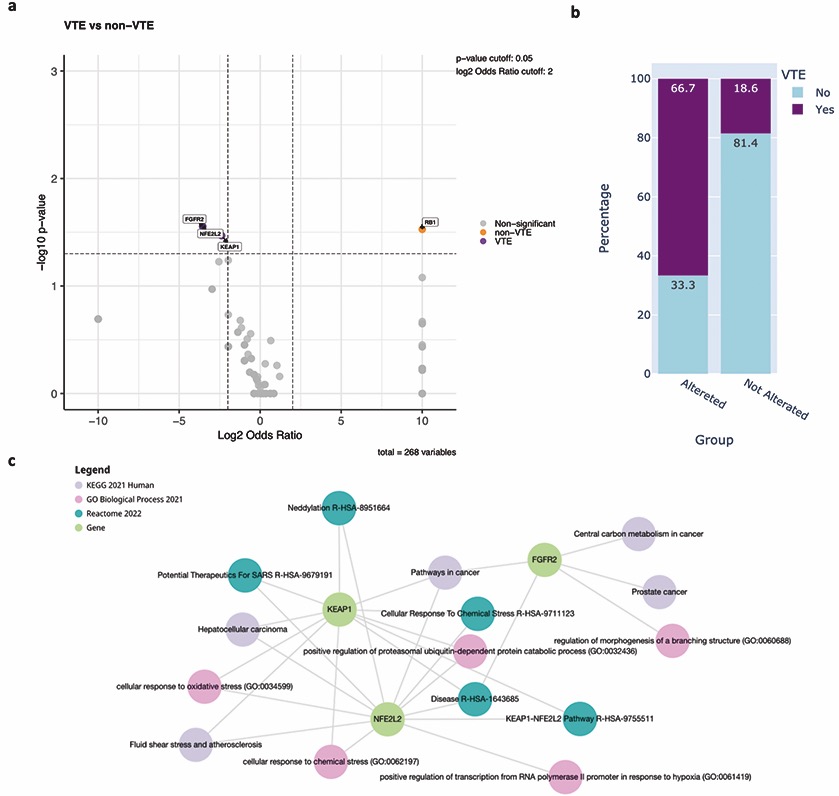29th National Conference of the Italian Society for the Study of Hemostasis and Thrombosis, 2025
Vol. 4 No. s1 (2025)
CS03 | Khorana risk score and genomic profiling for prediction of venous thromboembolism in ovarian cancer
P. Santini, F. Mancinetti, S.M.P. D’Ambrosio, M. Bigossi, A. D’Errico, E. Fondi, G. Fracassa, E. Ianuà, L. Mastrantoni, G. Anderson, F. Camarda, I. Marino, J. Preziosi, M. Buttarelli, M. Manfredelli, A. Minucci, F. Persiani, L. Giacò, T. Pasciuto, I. Conti, I. Mozzetta, C. Marchetti, V. Salutari, G. Scambia, C. Nero, R. Pola | Agostino Gemelli University Polyclinic Foundation IRCCS, Roma, Italy
Publisher's note
All claims expressed in this article are solely those of the authors and do not necessarily represent those of their affiliated organizations, or those of the publisher, the editors and the reviewers. Any product that may be evaluated in this article or claim that may be made by its manufacturer is not guaranteed or endorsed by the publisher.
All claims expressed in this article are solely those of the authors and do not necessarily represent those of their affiliated organizations, or those of the publisher, the editors and the reviewers. Any product that may be evaluated in this article or claim that may be made by its manufacturer is not guaranteed or endorsed by the publisher.
Published: 22 October 2025
52
Views
0
Downloads
Similar Articles
- Stefania Cavazza, Gualtiero Palareti*, Still unmet problems with low molecular weight heparin prophylaxis of venous thromboembolism. An Italian survey , Bleeding, Thrombosis and Vascular Biology: Vol. 4 No. 3 (2025)
- Alice Lipari, Esmeralda Capristo, Antonietta Ferretti, Erica De Candia, Anticoagulation in obese patients: challenges and strategies , Bleeding, Thrombosis and Vascular Biology: Vol. 4 No. 3 (2025)
- PO15 | Venous thromboembolism risk associated with midline catheters and peripherally inserted central catheters: a systematic review and meta-analysis , Bleeding, Thrombosis and Vascular Biology: Vol. 4 No. s1 (2025)
- Mehrie H. Patel, Alok A. Khorana, New drugs, old problems: immune checkpoint inhibitors and cancer-associated thrombosis , Bleeding, Thrombosis and Vascular Biology: Vol. 3 No. s1 (2024)
- Gary E. Raskob, Risk of recurrent venous thromboembolism in cancer patients after discontinuation of anticoagulant therapy , Bleeding, Thrombosis and Vascular Biology: Vol. 3 No. s1 (2024)
- Kristen M. Sanfilippo, Tzu-Fei Wang, Venous thromboembolism and mortality in patients with hematological malignancies , Bleeding, Thrombosis and Vascular Biology: Vol. 3 No. s1 (2024)
- Maria Barca-Hernando, Victor Garcia-Garcia, Luis Jara-Palomares, Location of metastasis and complications in patients with venous thromboembolism and cancer: a systematic review , Bleeding, Thrombosis and Vascular Biology: Vol. 3 No. s1 (2024)
- Sarah Gallitto, Thomas C. Varkey, Jacob Lahti, Venous thromboembolism prophylaxis in orthopedic surgery: a narrative review , Bleeding, Thrombosis and Vascular Biology: Vol. 3 No. 3 (2024)
- Daniela Tormene, Elena Campello, Chiara Simion, Anna Poretto, Paolo Prandoni, Paolo Simioni, Combined oral contraceptives and the risk of venous thromboembolism carriers of antithrombin, protein C or S deficiency: Sub-analysis of a prospective cohort study , Bleeding, Thrombosis and Vascular Biology: Vol. 1 No. 3 (2022)
- Paolo Prandoni, Franca Bilora, Raffaele Pesavento, Giorgina Salgueiro, Angeles Blanco-Molina, Raquel Lòpez-Reyes, Manuel Monreal, and the RIETE Investigators, Treatment of venous thromboembolism in pregnancy: findings from the RIETE Registry , Bleeding, Thrombosis and Vascular Biology: Vol. 1 No. 2 (2022)
1-10 of 81
Next
You may also start an advanced similarity search for this article.









